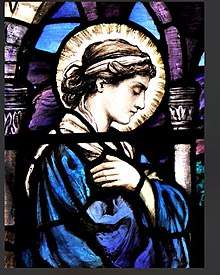Mary Lowndes
| Mary Lowndes | |
|---|---|
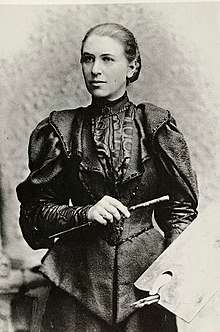 Mary Lowndes, 1890 | |
| Born |
1857 Dorset, England |
| Died |
1929 Buxted, East Sussex, England |
| Education | Slade School of Fine Art |
| Movement | Arts and Crafts Movement |
Mary Lowndes (1857–1929) was a British stained-glass artist who co-founded the stained glass studio and workshop, Lowndes and Drury in 1897. She was an influential leader in the Arts and Crafts Movement, not only for her stained glass work and successful studio-workshop, but also for opening doors for other women stained glass artists. She was an active participant in the suffragette movement, acting as Chair of the Artists' Suffrage League, and creating poster art to assist the movement.
Early life and work
Lowndes was born in 1857, the daughter of the rector of St Mary's Church, Sturminster Newton, Dorset. She received her art training at the Slade School of Fine Art in London.[1] When Lowndes completed her art classes, she became an assistant to prominent stained glass designer, Henry Holiday. She worked at his studio-workshop where she drew cartoons (designs) for stained glass commissions. While working for Holiday, Lowndes taught herself the techniques of stained glass. The first window Lowndes painted, was a two-light window, titled ‘’Feed my sheep’’, completed in 1893 for St. Peter’s church, Hinton St. Mary, Dorset.[2]
Lowndes lived and worked in Chelsea, where she had her own studio to work on designs, but there was no workshop nearby to complete her stained glass work. She would travel to Southwark, to the Britten and Gilson studio-workshop, where she would select the coloured glass for her commissions, paint the glass and supervise the firing and glazing of the windows. Lowdes worked as a stained glass designer for James Powell & Sons from 1887—92.[1]
Lowndes was one of the first women to work professionally in the world of stained glass in the 1890's. "Women, generally amateurs might occasionally design windows and even take some part in their execution, but they rarely, if ever practiced the whole art independently as a full time professional occupation".[2]
Lowndes and Drury
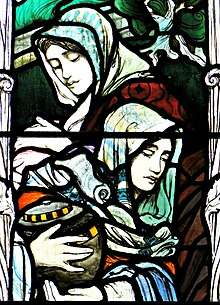
While working at the Britten and Gilson workshop, Lowndes met renowned stained glass artist, Christopher Whall. Lowndes admired Whall's innovative stained glass, and her early work demonstrate Whall's artistic influence.[2] In 1897, with the encouragement of Whall, Lowndes established her own studio-workshop with Alfred J. Drury.[2] Drury was the foreman at the Britten and Gilson workshop, and co-instructor of stained glass with Christopher Whall at the Central School of Arts and Crafts.[2]
The new studio-workshop in Chelsea was named Lowndes and Drury.[3] The new venture developed out of Lowndes and Drury's shared experience of working for a big studio. They created their new enterprise to meet the needs of the new school of independent artists associated with the emerging Arts and Crafts Movement. The new studio workshop would provide the technical facilities to allow artists to work on all stages of their stained glass commissions, from design thru glass selection, painting and glazing. [2]
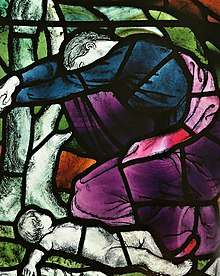
The partnership was established with an initial investment of 30£'s from each partner. Lowndes also provided a 200£ loan and additional loans of 280£ from Lowndes's companion, Barbara Forbes, her aunt, Miss Alice Vivian Kaye and friend, Miss J.F. Pearson. Along with Drury's small investment, the new firm was totally financed in its early years by these four women.[2]
Lowndes managed the new business with Drury, but chose not to be chief designer of the workshop. Like other workshop clients, she primarily used the facilities to work on her own stained glass commissions. Lowndes's stained glass work was highly regarded and in great demand at the time. Lowndes's stained glass work can be seen in parish churches throughout England and Wales.[1]
In 1906, with the need for bigger facilities, Lowndes and Drury founded the Glass House in Lettice Street, Fulham. The building at 9, 10, 11 and 12 Lettice Street was established as a stained-glass studio for works commissioned by Lowndes and Drury and for use by independent artists. It was a purpose-built stained-glass studio and workshop designed by Christopher Whall and Drury. The Glass House attracted many artists, like Wilhelmina Geddes, Christopher Whall, and Robert Anning Bell. The Glass House was renowned for its work. In the early twentieth century, it was considered the most important studio-workshop for stained glass associated with the Arts and Crafts Movement.[2][4]
Suffragette movement

Lowndes became involved in the Women's suffrage movement in Britain in the 1890's. In 1899, she attended the International Congress of Women in London.[3] In January 1907, Lowndes established The Artists' Suffrage League (ASL) to create dramatic posters, postcards, Christmas cards, and banners for suffrage events. She became its chair and Forbes, her companion, was the secretary.[3][5]
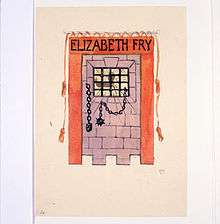
Between 1903 and 1914 the methods used by the women's suffrage movement began to change and they began to engage in public demonstrations and other propaganda activities. Lowndes' training as an artist and stained-glass designer encouraged the use of bold shapes and a love of full, rich colours, using striking combinations of green and blue, magenta and orange.[5]
Lowndes was also active in the national Suffragette movement, including her leadership on the National Union of Women's Suffrage Societies executive committee.[6]
She was a member of the committee of the Englishwoman and contributed regularly to the magazine.[3]
Personal life
Lowndes lifelong companion was Barbara Forbes, the secretary of the Artists' Suffrage League founded by Lowndes.[3] Throughout her life, Lowndes suffered from chronic asthma.[2]
Lowndes died in 1929 and was buried in Buxted, East Sussex, England. She left Forbes a sum of money, all her pictures, prints, cartoons, studio effects and her shares in the Englishwoman Ltd.[3]
Selected stained glass work
- All Saints' Church, Childwall, Liverpool
- Holy Innocents, Lamarsh, Essex (a scheme of three windows over several years)
- Holy Trinity, Aberaeron, Ceredigion[1]
- St Andrew, Boxford, Berkshire
- St Andrew, Meonstoke, Hampshire
- St Andrew, Ufford, Cambridgeshire (the entire chancel scheme)
- St Christopher, Haslemere, Surrey
- St Erme, St Erme, Cornwall
- St George's Church, Altrincham, Cheshire
- St John the Baptist, Snape, Suffolk
- St John the Baptist, Wittersham, Kent
- St Leonard, Heston, London
- St Margaret, Mountain Ash, Rhondda Cynon Taff[1]
- St Mark, Marylebone, London[3]
- St Mary, Ewshot, Hampshire
- St Mary, Linton, Cambridgeshire
- St Mary, Pimlico, London
- St Mary, Spittal, Pembrokeshire[1]
- St Mary, (Sturminster Newton), Dorset - 2 windows
- St Mary, Welwyn, Hertfordshire
- St Mary and St Blaise, Boxgrove, Sussex
- St Peter, Great Cheverell, Wiltshire
- St Peter, Henfield, Sussex
- St Peter, Machynlleth, Powys[1]
- St Peter, Shropham, Norfolk
- St Tydecho, Cemaes, Powys[1]
- St Yeghiche (Armenian), Kensington, London
Posthumous recognition
Lowndes's name and picture (and those of 58 other women's suffrage supporters) are on the plinth of the statue of Millicent Fawcett in Parliament Square, London, unveiled in 2018.[7]
Gallery
 Lowndes's first stained glass window, Hinton St Mary, Dorset (1893)
Lowndes's first stained glass window, Hinton St Mary, Dorset (1893)
 Sts Peter and Paul, Mersea Island, Essex (1905)
Sts Peter and Paul, Mersea Island, Essex (1905)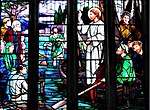 St Erme Parish, Cornwall (1906)
St Erme Parish, Cornwall (1906) Taplow, Buckinghamshire, (1912)
Taplow, Buckinghamshire, (1912)
References
- 1 2 3 4 5 6 7 8 "Mary Lowndes (1857-1929)". Stained Glass in Wales. Retrieved 9 January 2018.
- 1 2 3 4 5 6 7 8 9 Cormack, Peter (2015). Arts & Crafts Stained Glass. Paul Mellon Centre. ISBN 978-0300209709.
- 1 2 3 4 5 6 7 Crawford, Elizabeth (2003). The Women's Suffrage Movement: A Reference Guide 1866-1928. Routledge. p. 358. Retrieved 9 January 2018.
- ↑ The Glass House, Hammersmith and Fulham. British Listed Buildings. Retrieved 10 September 2012.
- 1 2 Lisa Tickner "Banners and Banner-Making". In Vanessa R. Schwartz and Jeannene M. Przyblyski, "The Nineteenth Century Visual Culture Reader". Routledge, 2004, London and New York.
- ↑ Lago, Mary. (1995). Christiana Herringham and the Edwardian Art Scene. University of Missouri Press. p. 287 ISBN 0826210244
- ↑ "Millicent Fawcett statue unveiling: the women and men whose names will be on the plinth". iNews. Retrieved 2018-04-25.
Further reading
| Wikimedia Commons has media related to Mary Lowndes. |
